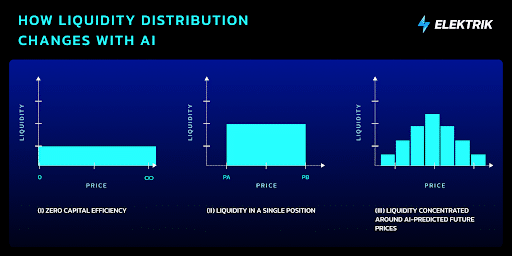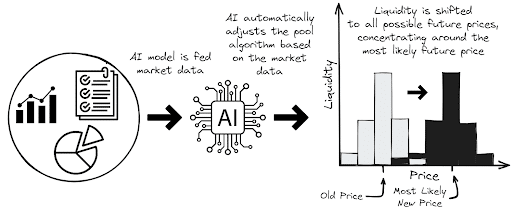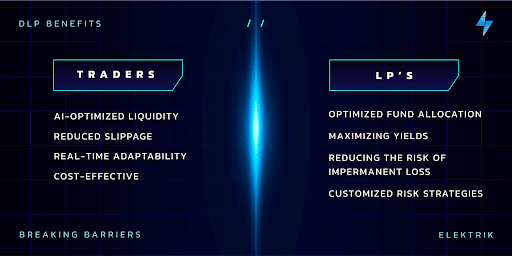Introduction
Decentralised finance (DeFi) at its core is fundamentally reliant on decentralised exchanges (DEXs). These pieces of web3 infrastructure are the arbiters of liquidity, facilitating the exchange of cryptocurrencies. Most of these DEXs, being reliant on automated market makers (AMMs), decide which price ranges to allocate liquidity towards in a token pool. The more accurate the allocation, the more efficient and performative the trading experience. Therefore, the success of any DEX is contingent on the effectiveness of its AMM. An ecosystem without efficient DEX infrastructure is less likely to succeed under the financial strain it places on users.
Without the development and deployment of DEXs atop advanced AMM infrastructure, DeFi itself would not be where it is today. Nevertheless, DeFi trading infrastructure has a long way to go before it catches up to the efficiency of TradFi infrastructure. This will necessitate the implementation of more advanced AMMs which rival the order book and market maker model employed by most TradFi exchanges. Hence, the development of Elektrik’s dynamic liquidity provision model, a next generation AMM designed in pursuit of unprecedented capital efficiency.
The Monumental Importance of Capital Efficiency in DEXs
‘Capital efficiency’ is a phrase which pops up often when discussing financial systems. At its core, capital efficiency refers to the strategic ability of a financial system, whether a business or otherwise, to maximise the work done by every dollar of capital expended. In simpler terms, it is the art of getting the most bang for your buck, ensuring that every financial resource is judiciously allocated and intelligently leveraged to reach its utmost potential. It is a concept especially pertinent for marketplaces and exchanges, since as costs of trading rise on an exchange, fewer users are likely to trade on it.
For exchanges, particularly DEXs, capital efficiency is not merely an operational best practice; it is the lifeblood that largely determines their viability. These platforms operate at the nexus of rapid trade execution, minimal slippage, and optimal order matching, wherein the significance of capital efficiency becomes glaringly evident. A DEX that cannot judiciously manage its capital will find itself dwarfed by competitors, as traders gravitate towards platforms offering the most favourable trading conditions. However, in attempting to achieve peak capital efficiency, DEXs are faced with challenges. Issues such as market volatility, fragmented liquidity pools, and unpredictable trading volumes can often distort the ideal capital allocation, leading to inefficient use of resources and subsequent diminished returns.
So, how can these platforms surmount these formidable challenges? The answer lies in the strategic amalgamation of traditional financial principles with emerging technologies. One such groundbreaking synergy is between liquidity provision and machine learning. By deploying machine learning algorithms, exchanges can predict trading patterns, anticipate liquidity demand, and adjust their capital allocation proactively. This dynamic approach to liquidity provision, powered by the analytical prowess of machine learning, ensures that capital is not just used, but optimised.
Solving this Problem with Dynamic Liquidity Provision (DLP)
Traditional AMMs have largely operated under the premise of algorithmically managed pools, the most obvious example being Uniswap V1’s x * y = k algorithm. Conversely, Elektrik’s Dynamic Liquidity Provision (DLP) model makes use of algorithmically managed pools which are constantly changed and updated via market conditions and artificially intelligent systems. These algorithms ensure that liquidity pools are automatically adjusted to meet market demands, providing not only a more efficient system but also a more profitable opportunity for liquidity providers. The very core of DLP is its capability to adapt, to mould itself to the ever-changing contours and multifaceted nature of the financial landscape, ensuring that liquidity is not just available but also dynamically optimised.
When it comes to the core of the DLP algorithm itself, hedging bets and ensuring market adaptability are central themes. To clarify, traditional AMMs often leave liquidity providers in a tough spot: seek higher yields but accept the greater risks associated with concentrated liquidity pools such as impermanent loss, or play it safe and lose out on potential profits. DLP resolves this dilemma by employing similar techniques to traditional market makers, dynamically allocating liquidity to where it is needed most while ensuring that there is sufficient market depth across the spread of possible price ranges. This strategy is backed by machine learning predictions, that aim to maximise LP fees while mitigating losses. The integration of these machine learning predictions with market data ensures that the system can quickly pivot its strategies based on real-time market conditions. This way, liquidity providers do not find themselves stuck in a detrimental position when the market shifts. Instead, the DLP system takes corrective actions, reallocating liquidity on the curve in a manner that is most suited to new and predicted market conditions.
What really sets DLP apart from the competition is its use of artificial intelligence (AI). When meshed into the DLP mechanism, AI offers an added layer of intelligent decision-making that can refine and enhance the algorithms which DLP uses to allocate liquidity. Here is how it works:
- Price Prediction: One of the primary tasks of the AI in DLP is to predict possible future prices of tokens in a trading pair. To do this, the AI dives deep into vast amounts of historical and real-time data. By analysing patterns, market behaviours, and other variables, it can project potential prices for assets in upcoming time frames.
- Price Likelihood Weighting: It’s not enough just to predict prices; the AI must also estimate how likely each of these prices will come to fruition. For example, if the AI predicts three potential prices for an asset in the next epoch, it assigns a weighting or likelihood percentage to each of those prices. This ensures that DLP can make more nuanced decisions about liquidity provisioning based on the most probable outcomes.
- Liquidity Allocation: Utilising the predicted prices and their weightings, the AI then strategically places liquidity on the curve. It does so by adjusting parameters like capital distribution ratios or risk exposure limits. For instance, if a particular price point has a high likelihood of occurring and aligns with the desired risk profile, the AI might allocate more liquidity around that price, ensuring that liquidity providers and traders get optimal results.
What sets DLP apart, then, is this use of AI to intelligently and dynamically manage liquidity. Traditional methods may rely on static rules or manual adjustments, but with DLP, the process is continually adapting based on comprehensive data analysis. This results in lower risk, higher yield, and a more adaptable liquidity provision system that responds to market variables almost instantaneously.
The true magic of DLP combined with AI lies in its continuous learning model. It is designed to consistently learn from its actions, monitoring the outcomes in real-time. For instance, if a specific liquidity pool is found to be underperforming or overexposed to a particular asset, the DLP algorithms, in real-time, reallocate resources, thereby reducing inefficiencies. What sets this apart is the iterative approach to fine-tuning the algorithms themselves, integrating new data to ensure that future decisions are even more accurate. This perpetual cycle of learning and adjusting translates into an asset management strategy that is well-aligned to navigate through the choppy waters of market volatility.
On top of the continuous learning model, DLP has been optimised using reinforced learning, a specialised machine learning technique. Here, algorithms learn by doing, constantly fine-tuning their actions based on a reward feedback system. For example, if the algorithm takes an action that results in more effective liquidity provision, perhaps by altering the weighting of assets in a pool and subsequently increasing yield, it receives a ‘positive reward.’ Over time, the algorithm uses this reward system to determine the most effective strategies, essentially training itself to improve performance continuously.
An additional feature of DLP’s machine learning approach includes integration with a meta learning model. Meta-learning, often referred to as “learning to learn”, is a paradigm within machine learning wherein algorithms improve by learning from experiences across multiple training episodes rather than from a singular dataset. The ‘meta AI’ employed by DLP updates and changes the datasets training its dependent machine learning models. It is able to discern between different types of market conditions and uses this knowledge to fine tune which datasets the other models use. The intent of this approach is to ensure that even the datasets employed by DLP are optimised for maximum performance depending on the task at hand.
What does this Mean for the End Users
Given the effectiveness of existing AMM infrastructure, the necessity of an innovation such as DLP might seem questionable. However, when considering the benefits incurred by the end user, its adoption appears inevitable. The purpose of DLP, as with many innovations in the financial sector, is to provide protocols with a means for achieving more with less. Unburdened by the strains of maintaining a costly financial infrastructure, DLP will allow us at Elektrik to provide more favourable conditions for traders and liquidity providers alike.
Traders
For traders, a seamless experience is the name of the game. They want a platform where they can execute trades quickly and continuously without losing out on slippage. DLP delivers here, offering traders levels of capital efficiency unmatched by static and manually adjusted dynamic liquidity pools. Its algorithms and AI systems work tirelessly to distribute liquidity where it’s predicted to be most needed, reducing the capital requirements for trading and, in turn, reducing slippage. The dynamic nature of DLP means that traders can anticipate consistently deep liquidity pools that facilitate larger transactions without significant price impact.
Real-time market adaptability is another jewel in the DLP crown. Trading is often about seizing fleeting opportunities, and the algorithms that govern DLP are designed to adapt to market conditions in real-time. These quick adjustments to liquidity pools mean that traders are less likely to face slippage and can capitalise on short-term price movements with greater efficacy. Lightlink further enhances this adaptability, with its rapid block speed allowing for swift transaction confirmations. Moreover, its enterprise mode offers gasless reallocation, ensuring that shifts in liquidity distribution don’t incur prohibitive gas costs. This adaptability does not just bring in operational efficiencies; it establishes a more predictable trading environment, one where opportunities are not lost to latency or outdated asset allocations when compared with centralised exchanges.
Liquidity Providers
For liquidity providers (LPs), the issue has always been about walking the tightrope between maximising fund utilisation and minimising risk. DLP fundamentally changes this equation by ensuring that funds are allocated where they are most likely to generate a high yield. This optimal fund utilisation does not just boost profitability; it also works to reduce impermanent loss, an issue that has long plagued traditional liquidity pools. Impermanent loss arises when the price of tokens in a liquidity pool shifts, causing the value of the tokens in the pool to differ from if they were held outside the pool. It occurs because LPs maintain a constant value ratio of the paired tokens, so when one token’s price increases relative to the other, the pool rebalances, often selling the appreciating token for the depreciating one. When LPers remain passive during significant price swings, they may experience this loss.
Furthermore, DLP affords liquidity providers a layer of customisation that cannot be understated. One size will never fit all, especially in financial markets where asset behaviours are highly nuanced. DLP allows providers to customise their strategies, backed by data-driven decision-making, ensuring a tailored approach that aligns with individual risk appetites and financial goals. This level of customisability means that liquidity providers are not just recipients of a one-size-fits-all solution; instead, they are active participants in a system that moulds itself around their specific needs and preferences.
Conclusion
In web3, terms like ‘machine learning’ and ‘artificial intelligence’ are often thrown around as buzzwords with relatively little genuine use-case. DLP stands out as the exception to this rule of thumb, exhibiting a genuine use case in the enhancement of AMM algorithms. This integration is pioneering, transcending the limitations of static liquidity systems and representing the next step in DEX technology.
While DeFi has made impressive strides, it thus far has failed to achieve parity with traditional financial systems in terms of efficiency and user experience. However, innovations such as Elektrik’s DLP, combining age-old financial principles with cutting-edge technology, are narrowing this gap. In the race towards an efficient, decentralised financial future, DLP is not just a significant advancement, but a harbinger of the immense potential and adaptability that DeFi holds for end users.


